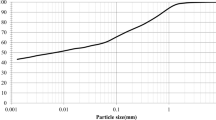Abstract
Soil chemical stabilisation is an effective soil improvement method involving the blending of hydraulic binder with an existing soft soil to enhance the geotechnical properties for improved mechanical performance. Arguably time- and cost-saving as well as less labour-intensive with minimum skill requirement, it is a favourable solution to the construction of rural and farm roads in often economically challenged and resources deprived regions, especially for sites overlying soft grounds like clay deposits. The present study explores the feasibility of stabilising clay type subgrade with a proprietary hydraulic binder admixed with fibrillated polypropylene fibres. The binder—0.9% fibre mix was blended with the base clay of kaolin at optimum water content, in dosages of 0, 1.5 and 4.0% per dry weight of the soil. Soaked and unsoaked CBR tests were carried out on the stabilised specimens at intervals of 3, 7, 14 and 28 days in duplicates to attain the targeted minimum CBR value of 5% stipulated by Malaysian Public Works Department. Stabilisation dosage of 1.5% was found to be inadequate under soaked conditions even with prolonged curing up to 28 days. It was only at 4% dosage that the 3-day old soaked specimen could meet the minimum requirement. 1.5% dosage treatment for the unsoaked specimens recorded CBR values of 12.1–25.0% after curing for up to a week, while a fortnight curing with the 4% dosage specimen raised the CBR value to >30. Overall, the soaked specimens attained about half the strength of the unsoaked ones, with 14 days observed to be the threshold before the strength increment rate plateaued. In summary, the binder-fibre mix could effectively strengthen the clay soil with higher dosages offsetting the curing time, though subject to dry or soaked curing conditions.
Access this chapter
Tax calculation will be finalised at checkout
Purchases are for personal use only
Similar content being viewed by others
References
Khan AJ, Ahmed SS, Hossain N, Islam MS (2016) Prediction of soaked CBR using index properties, dry density and unsoaked cbr of lean clay. Malays J Civil Eng 28(2):270–283
Jabatan Kerja Raya Malaysia (2013) Public Works Department of Malaysia. ATJ 5/85 (Pindaan / Amendment 2013) Manual for the Structural Design of Flexible Pavement
Yashas SR, Harish SN, Muralidhara HR (2016) Effect of California bearing ratio on the properties of soil. Am J Eng Res (AJER) 5(2):28–37
Tan KL (2017) Chemical stabilization of clay soil as road base for rural road. Universiti Tun Hussein Onn Malaysia: Bachelor’s Degree Final Year Project: Thesis
Prabhakar K, Reddy KR (2016) Strength characteristics of coir fibers and fly ass on soil. Int J Eng Sci Comp 6(10):2961–2969
Gupta D, Kumar A (2016) Strength characterization of cement stabilized and fiber reinforced clay-pond ash mixes. Int J Geosynthetics Ground Eng 2(4):32
Kanalli SA, Palankar R, Kumar B, Kumar P (2014) Comparative study of polymer fibre reinforced concrete with conventional concrete pavement. Int J Res Eng Technol 3(1):139–143
Parasor SJ (2017) Application of polypropylene fibre as a reinforced concrete. Int J Eng Res Mech Civil Eng 2(11):38–41
Acknowledgements
The project is made possible via collaboration with MTS Fibromat (M) S/B, who provided research materials and funds for the study. Technical support and assistance by the laboratories at UTHM are duly acknowledged too.
Author information
Authors and Affiliations
Corresponding author
Editor information
Editors and Affiliations
Rights and permissions
Copyright information
© 2022 The Author(s), under exclusive license to Springer Nature Switzerland AG
About this paper
Cite this paper
Chan, CM., Nasri, A.R.A., Tan, PC., Ng, D. (2022). CBR Characteristics of Kaolin-Simulated Clay Type Subgrade Stabilised with Cement, Lime, Poly-Fibre and Ionic Compounds mix. In: Tutumluer, E., Nazarian, S., Al-Qadi, I., Qamhia, I.I. (eds) Advances in Transportation Geotechnics IV. Lecture Notes in Civil Engineering, vol 164. Springer, Cham. https://doi.org/10.1007/978-3-030-77230-7_68
Download citation
DOI: https://doi.org/10.1007/978-3-030-77230-7_68
Published:
Publisher Name: Springer, Cham
Print ISBN: 978-3-030-77229-1
Online ISBN: 978-3-030-77230-7
eBook Packages: EngineeringEngineering (R0)




